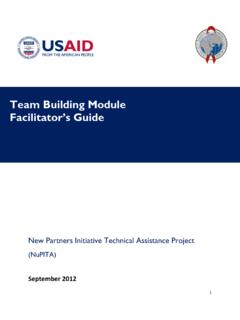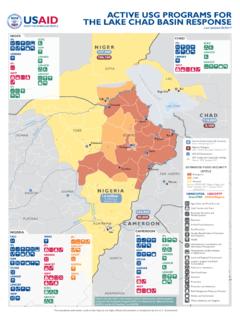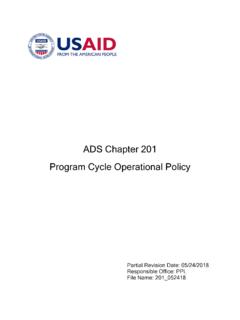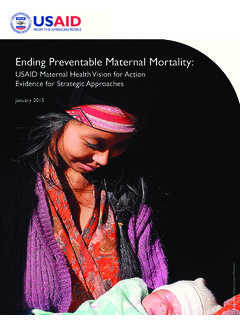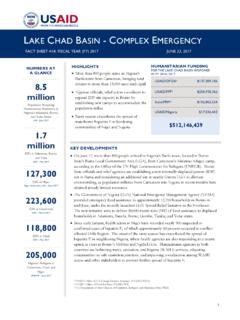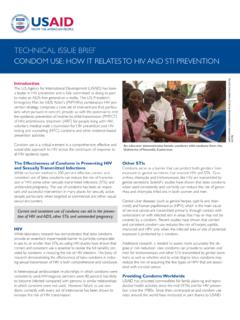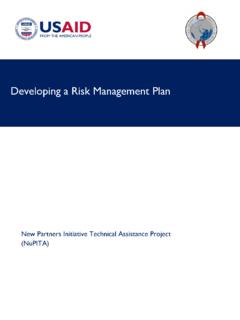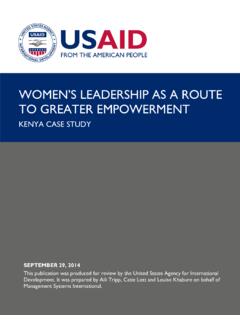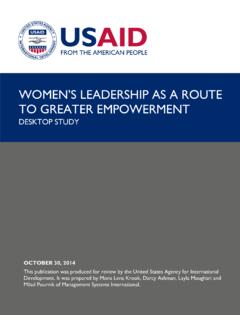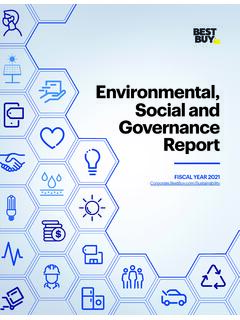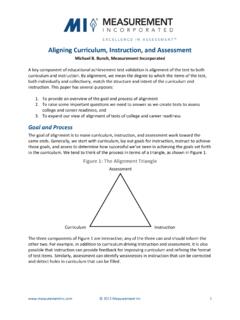Transcription of Technical Evaluation Committee Process Instruction Guide ...
1 Technical Evaluation Committee Process Instruction Guide and Template A Mandatory Reference for ADS Chapter 300 New Edition Date: 04/02/2013 Responsible Office: M File Name: 300mag_040213 Technical Evaluation Committee MEMBER Guide AND TEMPLATE BUREAU FOR MANAGEMENT (M) OFFICE OF ACQUISITIONS AND ASSISTANCE TEMPLATES SERIES MAY 2012 Introduction The purpose of the guidance is to convey to you responsibilities of individuals serving as members of a Technical Evaluation Committee . The Technical Evaluation Process is an analysis of each offeror s proposal with respect to the standards and criteria established in the source selection plan and as set forth in the solicitation.
2 The Technical Evaluation Committee s (TEC) objective is to evaluate each offeror s Technical proposal against the Evaluation factors established in the solicitation to determine if the offeror is able to the perform the tasks that are outlined in the Statement of Work (SOW). It is imperative that each member of the TEC become familiar with the solicitation and all supporting documents referenced in the solicitation before looking at the offeror s Technical proposal. Each evaluator independently scores/rates each Technical proposal and documents in narrative the offeror s strengths, weaknesses, significant weaknesses and deficiencies as it relates to the Evaluation factors and sub-factors outlined in the solicitation.
3 In order to obtain a comprehensive understanding of the Evaluation Process you should also review the following guidance: Source Selection Plan Guidance and Template, Technical Evaluation Committee Chairperson Guide and Template, Technical Evaluation Committee Process Instruction Guide and Template, Cost Realism Key Components Guidance and Checklist and the Harmonization Guidance Section C (SOW) to - Section L and M. Audience Agreement Officer Agreement Officer s Technical Representative Contracting Officer Contracting Officer s Technical Representative Contract Specialist Program Analyst/Activity Manager Agreement Specialist Budget Officer Technical Evaluation Committee Acronyms CO Contracting Officer COR Contracting Officer Representative CRB Contract Review Board CR Competitive Range CTO Cognizant Technical Office FAR Federal Acquisition Regulation GC Office of the General Counsel IQC Indefinite Quantity Contract OAA Office of Acquisition and Assistance OSDBU Office of Small and Disadvantaged Business Utilization RFP Request for Proposal SSA Source
4 Selection Authority SSP Source Selection Plan TEC Technical Evaluation Committee Key Roles and Responsibilities Source Selection Authority (SSA) is the individual designated to make the best-value decision. The SSA is the CO unless another individual has been designated in writing by the appropriate authority. The CO decision shall be based on a comparative assessment of proposals against all source selection criteria in the solicitation. While the CO may use reports and analyses prepared by others, the source selection decision shall represent the CO's independent judgment. Contracting Officer (CO) is responsible for coordinating with the Activity Manager to define the acquisition requirements, entering into, administering, and terminating USAID-direct contracts in accordance with the limitations of their delegated authority, policy directives, and required procedures.
5 Technical Evaluation Committee (TEC) Chairperson is responsible for the overall management of the TEC, can also be an elevator, and act as the TEC s interface to the CO. The TEC chairperson is responsible for ensuring the adequacy of documentation and the team s Evaluation of the proposals received. Contracting Officer s Representative (COR) is designated by the Contracting Officer, and is responsible for the Technical oversight and administration of the activity during contract performance. Contract Review Board (CRB) is often comprised of Contracting Officers, members from Evaluation and Policy offices and when required, a representative of General Counsel.
6 The CRB is responsible for reviewing documentation for acquisition actions (pre-solicitation, competitive range determination, and pre-award) that are expected to exceed $25M. This includes basic Indefinite Quantity Contracts (IQCs) with the total estimated ceiling expected to exceed $25M for single or multiple awards. General Counsel (GC) is responsible for advising the CO and TEC on legal issues relating to the source selection Process . Definitions Below are definitions of terms used to describe different elements in the offerors proposals. These definitions are drawn from the FAR Part 15. Pay careful attention to the distinctions, , a weakness is not required to be shared during discussions with offerors, however, significant weaknesses are required to be shared.
7 Significant Strengths An outstanding, or exceptional aspect of an Offeror s proposal that has merit and exceeds the specified performance or capability requirements in a way beneficial to the USAID, and either will be included in the contract or is inherent in the Offeror s Process and greatly increases the likelihood of successful performance. Strengths: An aspect of the proposal that increases the likelihood of successful contract performance. Clarification: Limited exchanges between the Government and Offerors that may occur when award without discussions is contemplated. Offeror may be given the opportunity to clarify certain aspects of the proposal ( , the relevance of an Offeror s past performance information and adverse past performance information to which the Offeror has not previously had an opportunity to respond) or to resolve minor or clerical errors.
8 Clarification does not give the Offeror an opportunity to revise or modify its proposal, except to the extent that corrections of apparent clerical mistakes result in a revision. Clarifications do not require discussions" or submission of another proposal. The Contracting Officer controls all clarifications and discussions with the Offerors. Deficiency: A material failure of a proposal to meet a Government requirement or a combination of significant weaknesses in a proposal that increases the risk of unsuccessful contract performance to an unacceptable level. Deviation: An Offeror s proposal implies or specifically offers a deviation below specified criteria. The Offeror may or may not have called the deviation to the Government's attention.
9 The Technical reviewers will identify deviations. The contract normally can't be awarded with deviations. A deviation is also known as a material deficiency. Discussions: Exchanges between the Government and offerors for the purpose of identifying to the offeror s significant weaknesses, deficiencies, and other aspects of the proposal that could, in the opinion of the contracting officer, be altered or explained to enhance materially the proposal's potential for award. Weakness: A flaw in the proposal that increases the risk of unsuccessful contract performance. A SIGNIFICANT WEAKNESS is a flaw in the proposal that appreciably increases the risk of unsuccessful contract performance.
10 All significant weaknesses discovered will be identified to the Offeror during discussions, if conducted , and in any debriefing after award has been made. The Contracting Officer may not award a contract to any Offeror who fails to correct significant weaknesses that are deemed essential. Guidance The TEC Members may be called upon, as required by the Chairman, to support any or all of the following source selection phases: (1) Evaluation ; (3) Consensus; (4) Report; and (5) Debriefing. All TEC members are required to be fully engaged and available through the entire Process . The CO convenes a Technical Evaluation Kickoff meeting with the TEC. The purpose of this meeting is to provide an overview at the beginning of the principles that when followed maintain the integrity of the Evaluation Process .
